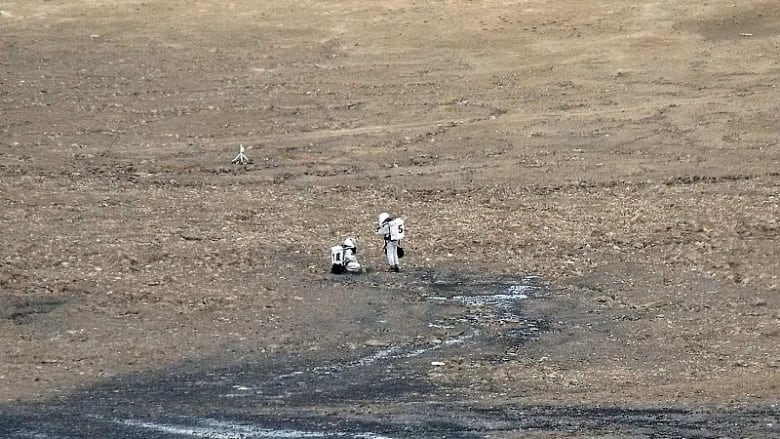Mars researchers return to Devon Island, Nunavut, for 'twin mission' with Utah
High Arctic island being compared to Utah, another Mars-like environment

A team of six would-be astronauts is settling into a research station on Devon Island, Nunavut, north of Baffin Island.
The team is studying lichens and geology, and in the process, learning how astronauts can someday live together on Mars.
The researchers are fresh off a relatedassignment in the Utah desert. The two studies are "twin missions," according to Paul Sokoloff, a researcher at the Canadian Museum of Nature.
"Both of these sites are excellent planetary analogues,"Sokoloffsaid. "We thought it was a really great progression to be able to say, 'OK, well, we know that these are both good Mars analogue sites,'but we've never done the exact same scientific program at both."
Sokoloff is supporting the mission from Ottawa, where he gets updates by satellite email from the crew on how their research programs are progressing.
"How do these Mars analogue sites stack up on earth, in terms of both biology, geology, crew training, crew morale, and isolation over long terms?" He said. "Those are the kinds of things we're researching."
Locked up in a 'tuna can' for 2months
The team itself has much less lofty goals; in fact, they're right on the ground.
They're studying lichens, because they're a good way to practise studying simple biology, and they're looking at permafrost polygons, shapes on the tundra that may also exist on Mars.
All the while, they're being studied themselves.
"Locking six people up in a tuna can for a couple months, that's a very real analogue to what it might be like getting people to Mars, and having them on Mars,"Sokoloffsaid.
The crew, however, say their accommodations are roomier than they're used to. In an email to CBC Thursday night, crewmembers write that"during the first Mars 160 expedition, we were at MDRS (Utah) with 7 crewmembers. Over here, the Hab is slightly bigger in diameter, and we are only 6. So, we have seen tighter. Our staterooms are tight, indeed, but we take it as a cocoon. It is in fact very comfy."
The team was delayed in arriving at the site due to weather. They spent weeks waiting to leave Resolute for the research station, which is designed to look and operate as much like a real Mars station as possible.
But they didn't waste time while in the small hamlet. The scientists visited the local school, teaching a science workshop.
"Was so fortunate to meet these little scientists," wrote Anushree Srivastava, a team member from the UK and India in a tweet.
We visited the Resolute Bay Science and Innovation Camp Open House. Was so fortunate to meet these little scientists :-) @ActuaCanada pic.twitter.com/9IrI6HgS1K
—@mycro_cosmNow that they have reached the station, the scientists are busy working on their research programs, which will be scaled back due to the delays.
"The new time constraints will not allow our crew scientists to conduct too much analysis, if any," wrote Alexandre Mangeot, the mission's French commander, in a blog post.
This kind of unforseen problem is to be expected, the crew added in an emailto CBC.
"When we go to explore remote places we know little about it and the conditions there. We have to plan according to what we think we know and be prepared to the unknown," they wrote.
The crew may not be dealing with the harsh Martian environment and lack of atmosphere yet, but the nature of the mission means the crew still has to wear space suits in the field except for one member, who will deal with one particular challenge of working in the High Arctic.
"The person who's the bear guard that day, they don't have to wear a space suit," explainedSokoloff.












_(720p).jpg)


 OFFICIAL HD MUSIC VIDEO.jpg)
.jpg)



























































































